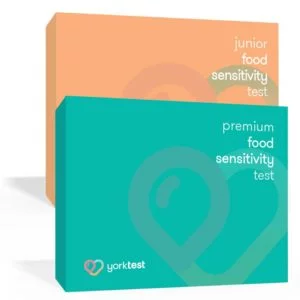- What is Celiac Disease?
- How common is it?
- What are the Symptoms of Celiac Disease?
- What are the Complications of Celiac Disease?
- Diagnosis of Celiac Disease
- What is a Gluten Intolerance or Gluten Sensitivity?
- What are the Symptoms of Gluten Intolerance?
- Diagnosis of Gluten intolerance
- What are the symptoms of Wheat Allergy?
- How to know which condition you have?
- How to test for Celiac Disease
- How to test for a Wheat Allergy?
- When to see your doctor
- Conclusions & Infographic
Gluten is a general name for a protein found in wheat. Acting as a glue that holds food together, gluten helps foods maintain their shape. It can be found in many types of foods, even ones that you might not expect (wheatberries, durum, emmer, semolina, spelt, farina, farro, graham, and einkorn). Gluten may also be found in other products like vitamins and supplements, hair and skin products, toothpastes, and lip balm. As you can see, it’s an incredibly common ingredient!
Celiac disease (CD), gluten intolerance, wheat sensitivity, and wheat allergy are all conditions where the primary treatment is avoidance of wheat or gluten containing foods.
However, despite having similar treatments, each condition is unique. There are differences in the symptoms and underlying symptoms which are important to understand if you think you may have a problem with gluten. In this guide, we explain these differences to help you decide on your next steps to seek help and support.
What is Celiac Disease?
Celiac disease (also called: Celiac sprue, Gluten-sensitive enteropathy, Nontropical sprueis)an autoimmune condition where your immune system attacks your own tissues via anti-transglutaminase and anti-endomysial antibodies when you eat gluten.
The immune system mistakes gluten as harmful to the body. The gluten combines with the autoimmune celiac antibodies to damages your gut (small intestine), so you are less able to take in nutrients. This immune response may be due to genetics (approximately 97% of people diagnosed with celiac disease have a recognizable associated gene mutation) and environmental factors.
How common is it?
Celiac disease is commonly found in people of Northern European descent, and it is estimated to affect 1% of the populations of Europe and North America. If you have a first-degree relative, such as a parent or child, who has celiac disease, you have a 10% chance of developing the disease.
What are the Symptoms of Celiac Disease?
People with celiac disease may experience a range of gut symptoms after eating gluten:
- diarrhea, which may smell particularly unpleasant
- stomach aches
- bloating and flatulence
- indigestion
- constipation
More general symptoms can also include:
- tiredness and fatigue due to malabsorption of nutrients
- weight loss
- an itchy rash (dermatitis herpetiformis)
- nerve damage (peripheral neuropathy)
- disorders affecting co-ordination, balance and speech (ataxia)
Children with celiac disease may be irritable, have delayed puberty and/or not grow at an expected rate.
What are the Complications of Celiac Disease?
Complications only tend to affect those who have been diagnosed with celiac disease and who do not follow a gluten-free diet. Long term complications due to the continuous malabsorption of nutrients can include:
- malnutrition
- weakening of bones (osteoporosis)
- iron deficiency (anemia)
- vitamin B12 and folate deficiency
- development of lactose intolerance
Diagnosis of Celiac Disease
If you have gastrointestinal symptoms after eating gluten and you suspect that you have celiac disease a healthcare provider will look for evidence of any gut damage via blood tests and a gut biopsy. However, it’s important to get tested for celiac disease before you try a gluten-free diet, so the tests can reveal how gluten affects your body as once you begin avoiding gluten, your gut will start to heal.
There is no cure for celiac disease and the only way to manage symptoms and prevent long term complications is to follow a strict gluten-free diet.
What is a Gluten Intolerance or Gluten Sensitivity?
Gluten intolerance also called Non-Celiac Gluten Sensitivity (NCGS) is different to celiac disease, it is also an immune response to gluten but solely involves gluten specific IgG antibodies.
However, both conditions can cause similar symptoms. It has been estimated that approximately 6% of the U.S. population is gluten intolerant.
What are the Symptoms of Gluten Intolerance?
- abdominal pain
- bloating or gas
- diarrhea or constipation
- irritable bowel syndrome (IBS)
- anxiety
- depression
- fatigue
- headache
- joint pain
- skin rash
Diagnosis of Gluten intolerance
A gluten-specific IgG test can be used to indicate gluten intolerance or gluten sensitivity and this is a good way of testing..
Some healthcare providers may suggest the following steps if they suspect that you may have a gluten intolerance or sensitivity:
- Eat a diet containing gluten for about six weeks. During this time, your healthcare provider may perform blood tests and skin tests (to rule out a wheat allergy or celiac disease).
- If you don’t have a wheat allergy or celiac disease, you may then be asked to exclude gluten from your diet for at least six weeks whilst keeping a diary of your symptoms, noting which (if any) symptoms improve during this time.
- If your symptoms improve while on a gluten-free diet, you will be asked to gradually reintroduce gluten back into your diet. If symptoms return, you likely have a gluten intolerance or sensitivity.
What is a Wheat Allergy?
Wheat allergy is sometimes confused with celiac disease, but these conditions differ in their cause.
A wheat allergy occurs when your body produces antibodies to any of the four classes of proteins found in wheat – albumin, globulin, gliadin and glutenin. Glutenin and gliadin proteins together make up gluten. Whereas in celiac disease, it is gluten specifically that causes an abnormal immune system reaction.
An allergic reaction to wheat can be triggered by eating wheat and in some cases, by inhaling wheat flour.
Avoiding wheat is the main treatment for a wheat allergy, but that isn’t always as easy as it sounds: wheat is often a hidden ingredient in many foods, even ones that we would not suspect like hotdogs or even ice-cream! Medications may be necessary to manage allergic reactions if you accidentally consume wheat.
What are the symptoms of Wheat Allergy?
A child or adult with a wheat allergy is likely to develop signs and symptoms within minutes to hours after eating something containing wheat. Common symptoms include:
- swelling, itching or irritation of the mouth or throat
- hives, itchy rash or swelling of the skin
- nasal congestion
- headache
- difficulty breathing
- cramps, nausea or vomiting
- diarrhea
- anaphylaxis
What is a Wheat Sensitivity?
Like a wheat allergy, a wheat sensitivity can be cause by any of the four classes of protein in wheat. Although closely related, the two conditions are not the same. The type of reaction your body has differs depending on whether you have a sensitivity or an allergy.
With wheat or gluten sensitivity, immunoglobulin G (IgG) is the antibody that’s triggered. Whereas with wheat allergy, immunoglobulin E (IgE) antibodies are the primary trigger, which typically cause more serious symptoms like those listed above.
Read our general guide on food sensitivities vs. food allergies to learn more.
How to know which condition you have?
Testing is a good way to determine which of these conditions you have. Let’s look at the different testing methods for celiac disease, wheat allergy and gluten or wheat sensitivity.
How to test for Celiac Disease
As mentioned, it’s important to be tested for celiac disease before trying a gluten-free diet as eliminating gluten from your diet might make the results of blood tests appear normal and allow the gut to heal.
Many people with celiac disease don’t know they have it, therefore 2 blood tests can help in its diagnosis:
- serology testing looks for antibodies in your blood. Elevated levels of certain antibody proteins indicate an immune reaction to gluten.
- genetic testing for human leukocyte antigens (HLA-DQ2 and HLA-DQ8) can be used to rule out celiac disease.
If the results of these blood tests suggest celiac disease, your doctor may order one of the following tests:
- endoscopy: This uses a long tube with a tiny camera at the end that’s put into your mouth and passed down your throat allowing your doctor to view your small intestine and take a small tissue sample (biopsy) to analyze for damage.
- capsule endoscopy: This test uses a tiny wireless camera, inside a vitamin-sized capsule, to take pictures of your entire small intestine.
Your doctor might take a small sample of skin tissue to examine under a microscope (skin biopsy) if they suspect you have dermatitis herpetiformis.
How to test for a Wheat Allergy?
A physical exam, a detailed medical history and some tests will help your doctor make a diagnosis. Tests or diagnostic tools may include:
- skin test: tiny drops of purified allergen extracts are pricked onto your skin’s surface. If you develop a red, itchy bump where the allergen was pricked onto your skin, you may be allergic.
- blood test: your doctor may order a blood test that screens for specific allergy-causing antibodies to common allergens, including wheat proteins.
- food diary: you may be asked to keep a detailed record of what and when you eat and when symptoms develop for a time.
- elimination diet: your doctor may recommend that you remove certain foods from your diet, particularly those that are common allergens. Under your doctor’s direction, you will gradually add foods back and note when symptoms return.
- food challenge testing: you eat food suspected of being the allergy-causing agent while being monitored for allergy symptoms. Under supervision, you begin with a small amount of the food and gradually increase the amount you consume.
How to test for Wheat and Gluten Sensitivity?
An At-Home Food Sensitivity Test can help determine whether wheat and gluten are causing an IgG reaction. Helping to identify the cause of the body’s response is crucial to knowing which dietary therapies are most effective for treatment.
The YorkTest Food Sensitivity Test takes just a few minutes to collect a blood sample It’s a simple finger-prick blood test you can take at home then mail back to our accredited laboratory for analysis. We test for reactions to 200 foods (including wheat and gluten) and you receive your results online within 7 days.
When to see your doctor
If you suspect that you or your child is allergic to wheat or another food, consult your physician. Equally, if someone shows signs of anaphylaxis, call 911 or your local emergency number, as anaphylaxis is a medical emergency that requires immediate care. You should also consult your physician if you suspect that you have celiac disease.
Conclusions & Infographic
In summary, wheat is an increasingly recognized trigger for wheat related disorders and immune mediated food allergies. Understanding the differences between celiac disease, wheat allergy, gluten intolerance and wheat intolerance can help recognize and treat these conditions.












